|
|
Review of navigation communicator HTC P3300 (Artemis)
Sales package:
- Communicator
- USB synch cable
- Charger
- Car charger
- Car Credle
- External GPS-antenna
- 512 Mb microSD memory card (optional)
- Wired stereo-headset
- Pouch
- Disks with software
- User’s Guide
HTC brand is barely familiar to the broad audience, as it has been only a couple of months since its official establishment. HTC still has a lot of promotional work to do – generally speaking, they have taken only the very first steps. For the time being the company feels vital need in proposing the range, as wide and soon as possible and getting into as many niches as it only can.

Until recently HTC’s range (back then – Qtek-branded devices) had had only a handful of models boasting a built-in GPS receiver. At present satellite navigation is all the range on the market – taking advantage of this slack competitors have already launched GPS-armed solutions, like Mio A700, E-Ten G500, HP iPaq hw6515, furthermore, other companies’ GPS-equipped models are coming up.
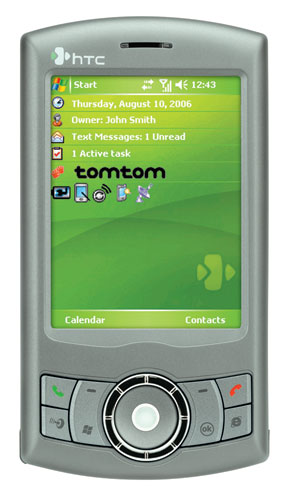
HTC’s main problem lies not in “missing” the birth of a relatively new trend, but rather in having its hand tied with a contract signed with HP (models coming from HP iPaq hw6500 series were developed and are being produced by). According to this agreement HTC was not at liberty to release a communicator with an embedded GPS module for some time after HP iPaq hw6500’s launch. However the company found a kind of way out by coming up with HTC Galaxy, which was a PDA lacking GSM module. But it was the first, and probably the last, “mere” PDA in HTC’s range. Even though the solution was mainly a failure (poor implementation of GPS), it allowed the company to acquire necessary experience profit by its own mistakes.
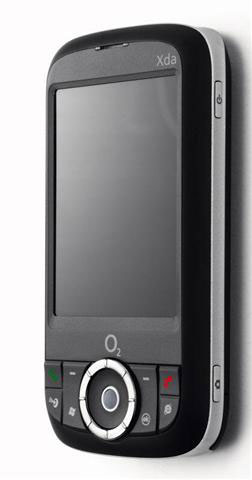
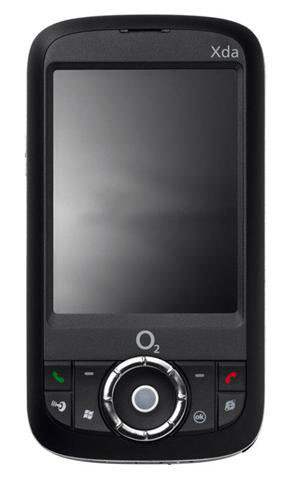
The model bearing “HTC Artemis” codename had been to hit the shelves with Qtek G200 index on its casing; however it ended up with HTC P3300 name, as the company is setting out to give unique names only to top-notch products (MTeoR, TyTN), at least that is what HTC’s representatives have to say. Following this logic, the P3300 is by no means a top solution, but a device that will most likely become of the company’s most popular solutions. The communicator will appear in retail stores not only under HTC’s own trade mark– operators, for example O2 XDA Orbit, will also have own-branded units. The design of the mentioned model, as can be found out on the image above, will slightly differ, though guessing its ancestor is really easy.

In course of its development within the company, the device’s appearance has undergone only minor alterations. The images above show how the communicator’s sketch looked a year ago. Nevertheless the spec sheet has significantly evolved as against initial company’s intentions – 1.3 Mpix camera model ended up being replaced with a 2 Mpix one, miniSD memory expansion slot – with microSD. Also a digital compass that had been on developers’ to-do list, was eventually left out.
Apart from the P3300, HTC will be producing model P3200 (codename – HTC Love, not announced yet). This unit will lack a GPS module and cost approximately 50 USD cheaper.
The device runs on HTC Wizard/Prophet platform – these are the solutions that powered the development of the P3300, although the base platform has been well-modified, so that now it keeps “low profile” – now it retains GPS, FM-radio, completely re-worked casing (in the sense of both materials used and design) and on top of all that, unique controls. At that, should we compare HTC Prophet (Qtek S200) and HTC P3200, while different design-wise, there two models are equal in terms of functionality. In time HTC P3200 will just take Qtek S200’s place on the market. Life cycle of Qtek S200 has not yet come to an end, that’s why the P3200 is still hidden in HTC’s sleeve.
Another important point concerning launch of a new model – partnership between HTC and TomTom. Until this moment it has been believed that new solutions would come with Destinator navigation application onboard. At that there are two possible packs – first, it’s so-called test edition (Taster) with only one free map being available, for example the one of London or, say, Moscow. Second, full package (Premium) that includes full Western European maps on a DVD and microSD memory card with 512 Mb onboard. The latter edition will cost about 230 USD more. The bad thing for Russia is that by the time shipments commence, TomTom Navigatior 6 and maps will not have been localized.
Design and controls
The device’s appearance looks out of place when compared to other HTC-branded solutions – one can readily figure out new concepts, unseen before in the company’s products. In my opinion, it’s the way of getting mature for the company, developing a more austere design. The P3300’s outlook is very distinctive and original – I could hardly force myself to call it a clone of something. The only thing beyond my grasp is why they would need to adopt Nokia 6680/6681’s silver side-framings.


The casing is made mainly of grey plastic. The sides are of some interest as well, since they feature not only metallic Nokia-style framings, but also rubberized “soft-touch” plastic – owing to that, tactile feelings of holding this non-slippery device are mostly favorable. Moreover, its dimensions and weight amplify overall ease of use. The casing found here is thinner and lighter than that of HTC Prophet – in a nutshell, it’s one of the market’s slimmest lightweights.
- HTC P3300: 108x58x16.3 mm, 127 g;
- HTC Prophet: 108.8õ59.3õ18.4 mm, 148 g;
- E-Ten M600+: 111.7x60.7x22 mm, 174 g;
- HP iPaq hw6800 (O2 XDA Atom): 102x58x19.5 mm, 140 g;
- GIGABYTE gSmart i: 106.6x53.2x19.8 mm, 136 g.

HTC’s build quality is traditionally splendid. One would need to put considerable efforts into finding a single gap here; when crunched the P3300 gives you the feeling of solidity and durability of its casing. The plastic the casing is made of looks expensive, and lives up to this impression when you touch it.
Controls found on the sides are “mounted” on the metallic framings – the left plate features volume control slider (third-party apps allow assigning other functions to it), dedicated voice control key and soft reset button, while on the right one will find shutter button and power key. All these buttons are very easy to locate and press. Due to not sticking out of the surface, the buttons cannot be pressed accidentally.

The upper rim’s slant houses external speaker’s grill, which is average sound-wise. The back panel holds camera module, self-portrait mirror and a socket for an external GPS-antenna.

The lower end of the device carries HTC ExtUSB connector (for plugging in charger, synch cable, headset) and holes for a carrying strap, so that one can wear the P3300 on neck on arm. The latter thing comes in handy, in case you use GPS when not in a car. There you will also find a slot containing a solid medium-sized stylus, which is quite convenient in day-to-day activities.
HTC Artemis doesn’t offer a usual joystick or navigation pad – these two are replaced with a very innovational trackball, coupled with a wheel. This combination goes by the name of HTC RollR.

The wheel can be turned either clockwise or counter-clockwise. Depending on speed you turn it with, scrolling speed in contacts, playlist and other lists, as well as speed of zooming in navigation app, changes correspondingly. At each 45 degrees turn you will hear a distinctive clicking noise. Similar control can be found on Samsung i300, though HTC P3300 doesn’t enable pressing the wheel in four directions – you can only scroll through lists. The key advantage of such wheel is ability to alter scrolling speed, which is impossible with a standard navigation key.
Video, wheel and trackball navigation (WMV, 8.8 Mb)>>>
And if the wheel, similar to that of the P3300 is carried by Samsung i300, the trackball is definitely a major innovation that mobile devices haven’t seen yet. On the face of it, it’s just a ball sticking out of the casing’s surface a little, which can be rolled in any desired direction. In order to get a better idea of how it works, imagine an old mouse (with a ball inside) that was turned upside-down. An interesting feature here is that the trackball is lit in bright blue while you are interacting with it, and gets dim when it’s out of work.

The trackball works in two modes – joystick-substitute and mouse. To confirm an action in either mode – press the trackball, or tap and hold for bringing up a context menu. While in the former mode, all you need to do is roll the ball in a desired direction, at that five-way is being emulated. The latter mode makes a mouse pointer appear on the screen that is managed with the help of the trackball.
Naturally, this solution requires some time to be proven, just like any other innovation does. As for me, such approach to navigation will be nothing more, but all another way to show off, even though its implementation here is better than iPaq hx4700’s touchpad. The company is not afraid of experimenting, propose unique solutions, that is the thing to admire – nobody can avoid making mistakes, but those who don’t risk will never make it to the world’s top. Most people who see this device get interested in it outright, furthermore, they really want to get their hands on it and play around with the trackball.

The only concern of mine upon the trackball is reliability – how many HTC RollRs will break down after, say, six months of operation, how often one will need to call at service centers to clean the ball… these are the questions that nobody can answer today.
Display
In the sense of all formal parameters, the display found on the P3300 is a standard one – it retains typical dimensions, resolution and color intensity. Measuring 2,84” (58x42 mm – active area) it puts up the resolution of 320x240 pixels and 65 K colors. However the viewing angles are not that good – the picture inverts, should you deviate from the right angle greatly. There are four illumination levels available, though the first one fits best for working in dark rooms, as it doen’t dazzle. On maximum backlighting intensity, one can easily keep working in a sunny day – information on the display remains readable, even though it fades a little.
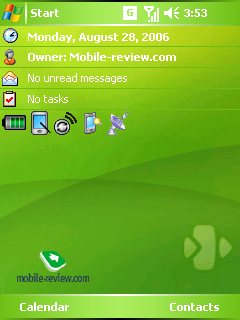
All in all, the P3300 features a typical display for a Windows Mobile-powered communicator, which doesn’t stand out against the background of its rivals.
Battery lifetime
The capacity of Li-Ion battery, used by the P3300, makes 1200 mAh. As the manufacturers claims, the device manages to last 3,5-5 hours in talk mode and about 6-8 days in standby, though in practice such figures look more like a dream. Average lifetime for this device, when used as a main handset, is two days (30-40 of calls a day, permanent Direct Push connection to MS Exchange from 10 AM to 6 PM, 30 minutes of web surfing, hour of listening to FM radio, 20 minutes of organizer use). Should you be heavier on music and Wi-Fi, the communicator will need to be recharged daily, and that’s the thing to reckon with. In case you use the P3300 only to make a couple of calls per day (up to 10 minutes in sum) and rarely turn to its extra functions, you might be able to squeeze 3-3,5 days of lifetime out of it.


Judging by the results displayed in course of out routine tests, valuing lifetime, model P3300 performs more or less on the same level with HTC Prophet/HTC Wizard. In e-book mode (minimal backlighting level, auto-scrolling in Haali Reader) the communicator lasted almost 23 hours, which is considerably better than HTC Wizard owing to low display’s energy consumption at dim backlighting. In music mode (playback of MP3-files with the bitrate of 128 Kbit/s stored on memory card, with deactivated display), the battery went low after 14 hours and 20 minutes. When it was given a real challenge (playback of video stored on memory card, maximized backlighting level), the P3300 managed to stay active for 5 hours and 40 minutes.


Fastening of SIM-card is standard. Having removed SIM you will reveal the socket for microSD card; therefore hotswap is non-existent on this device at all. On the whole, it’s a serious shortcoming for those used to switching memory cards regularly. But generally speaking, there is only one negative thing about this – data transfer speed with a card-reader is exceedingly higher than that with a synch cable. At present microSD memory cards are topping out at 2GB capacity.
Camera
The model houses a 2 Mpix CMOS-powered camera module. Unlike HTC Prophet (Qtek S200), here you won’t find macro-mode, as well as auto-focus and flash. Even though the snaps taken with the P3300 don’t break the ground, they appear to be quite good quality-wise. One of the most positive changes is enhanced color rendering, so that from now on bright areas on pictures don’t get filled with white only. In daylight, one can snap really nice-looking shots, but once you move to darker places or need to have a macro-shot, everything changes for worse.

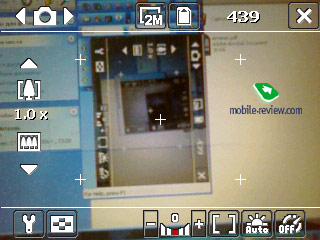

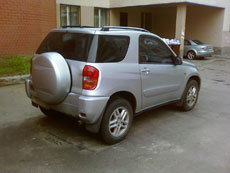 |
 |
(+)
óâåëè÷èòü, 1600x1200 |
(+)
óâåëè÷èòü, 1600x1200 |
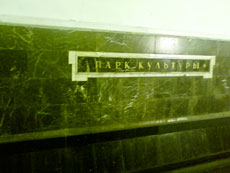 |
 |
(+)
óâåëè÷èòü, 1600x1200 |
(+)
óâåëè÷èòü, 1600x1200 |
 |
 |
(+)
óâåëè÷èòü, 1600x1200 |
(+)
óâåëè÷èòü, 1600x1200 |
 |
 |
(+)
óâåëè÷èòü, 1600x1200 |
(+)
óâåëè÷èòü, 1600x1200 |
 |
 |
(+)
óâåëè÷èòü, 1600x1200 |
(+)
óâåëè÷èòü, 1600x1200 |
 |
 |
(+)
óâåëè÷èòü, 1600x1200 |
(+)
óâåëè÷èòü, 1600x1200 |
 |
 |
(+)
óâåëè÷èòü, 1600x1200 |
(+)
óâåëè÷èòü, 1600x1200 |
 |
 |
(+)
óâåëè÷èòü, 1600x1200 |
(+)
óâåëè÷èòü, 1600x1200 |
A few words about the camera’s interface and settings. The camera itself is managed by HTC Camera for Pocket PC 4.03. Current resolution can be adjusted either in Settings or by pressing a corresponding icon with the stylus. The following options are available:
- 2M – 1600x1200 pixels
- 1M – 1280x960 pixels
- L – 640x480 pixels
- M – 320x240 pixels
- S – 160x120 pixels
Picture quality (affects mainly size):
- Super Fine
- Fine
- Normal
- Basic
White balance:
- Auto
- Daylight
- Night
- Incandescent
- Fluorescent
Effects:
- Grayscale
- Sepia
- Cool
- Negative
Contrast, Saturation, Hue, Sharpness, Contrast can be adjusted as well (by default these settings are on auto). Other features include – self-timer, on-picture date and time, silent shutter and some more.
Using RollR one can quickly switch between modes and go into video capture, for example. Video clips are saved in MPEG4, MotionJPEG, H.263 formats in M (176x144 pixels) or S (128x96 pixels) resolution. In all other respects the settings for video match those for still images. The video recorder also enables you to turn on/off sound recording, set duration or size caps. However quality and resolution of video clips captured by the P3300 leave much to be desired – take a look at the sample:
Sample video (mp4, 292 Kb)>>>
Apart from photo and video modes, the camera offers a couple of others – video for MMS, snapshot for contact, “sport” and burst modes. A series of 5 images taken at miserable intervals – that is what “sport” mode is, in its turn Burst allows you to get 30 pictures at a time.
Connectivity
The model retains reasonably lengthy list of interfaces, which we are about to describe. HTC ExtUSB connector acts as miniUSB-socket and a slot for the bundled headset (user is unable to plug in a headset of his/her own and limited to the one found in the package). At that it provides moderate sound quality with disputable design – not everyone will find this type of earphones appealing. ExtUSB connector significantly cuts down the communicator’s chances of performing on a par with a music player. Though, the device’s day is partly saved by good stereo Bluetooth-headset. Naturally, this connector is compatible with standard chargers and USB cables of older models.
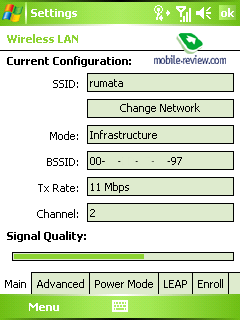 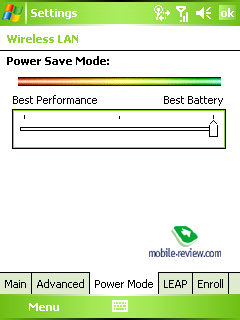
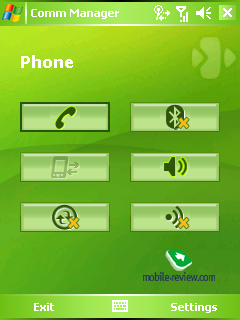
Wi-Fi (IEEE 802.11b/g). Wireless connectivity works in a convenient fashion – owing to installed AKU 3.0 update pack, the P3300 boasts support for WPA2 security standard, which provides the highest level of security to date. In Wi-Fi settings you can tune Wi-Fi power consumption.
Bluetooth 2.0 without EDR, but boasting considerably increased number of supported profiles. Bluetooth module is managed by standard Microsoft’s drivers. Let us see what BT here can do and for what purpose.
- Serial Port Profile (SPP). Emulates COM-connection of devices. Used mainly for synchronization with desktop PC, coupling external Bluetooth-gadgets, like Bluetooth GPS-receiver.
- Object Push Profile (OPP). A basic profile for sending "objects" such as pictures, virtual business cards, or appointment details.
- File Transfer Profile (FTP). Provides access to the file system on another device. This includes support for getting folder listings, changing to different folders, getting files, putting files and deleting files. For the first time this profile is implemented on HTC devices basing off Microsoft’s stack.
- Hands-Free Profile (HFP). Connection of Bluetooth-headset and handsfree device.
- Human Interface Device Profile (HID). Connection of Bluetooth-keyboard.
- Advanced Audio Distribution Profile (A2DP). Sound transfer via Bluetooth.
- Audio Video Remote Control Profile (AVRCP). Music playback management via wireless headset.
- Personal Area Network Profile (PAN). Network connection via Bluetooth, use for connection of a desktop PC to Internet through the communicator, replaces Dual-Up Networking profile.
- SIM Access Profile (SAP). Allows connecting to a SIM card in a phone with Bluetooth, so the car phone itself doesn't require a separate SIM card
We have tested all these profiles, saving for the last one (SAP) and are now confident to state that Bluetooth found in the P3300 deserves a very high mark – everything works fine.
HTC P3300 is attributed to the second generation, which means 3G/UMTS support is missing here. The communicator handles four GSM bands and has EDGE class B, multi-slot class 10 onboard. Infrared is also absent in its spec sheet; however we are not going to consider it to be a crucial drawback.
FM-radio
HTC Artemis is the first HTC’s device with embedded radio module, but it isn’t the single one on the market of devices running on Windows Mobile, though. Before the P3300 there were O2 XDA Atom, E-Ten G500, GIGABITE gSmart.
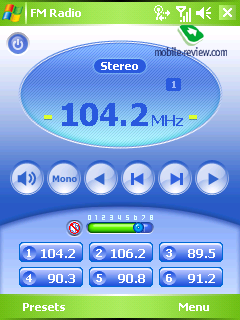 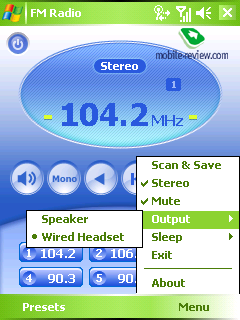
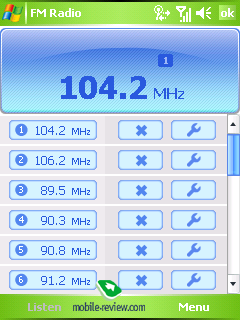
Embedded applet for FM-radio is comfortable in use. The program has 20 radio stations memory; manual search is enabled. The drawbacks are lack of the display sleep mode, no skins supported. Blue color is not peculiar to the green corporative tones of HTC. The radio is quite standard quality-wise and proposes nothing fundamentally new.
Specifications, performance
The heart of HTC Artemis is Texas Instruments OMAP 850 CPU whose frequency tops out at 200 MHz (inquisitive readers may find more details here). Volume of RAM makes 64 Mb, where 42.55 Mb can be managed by user, plus flash-memory (intended for storing users’ data) – 48.02 Mb (out of 128 Mb). The RAM volume is quite enough for stable operation; by plugging in a microSD card, amount of bundled flash-memory becomes insignificant.
Evaluation the device’s performance we will traditionally begin with SPB Benchmark pack. As time goes by the pack becomes less and less appropriate even facing off Windows Mobile-based devices. For comparison
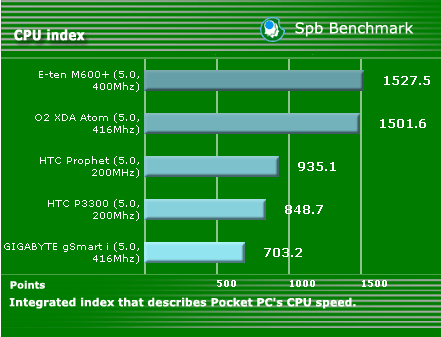
The index shows the CPU output. 200 MHz CPU is unlikely to hold a record but the result is good.
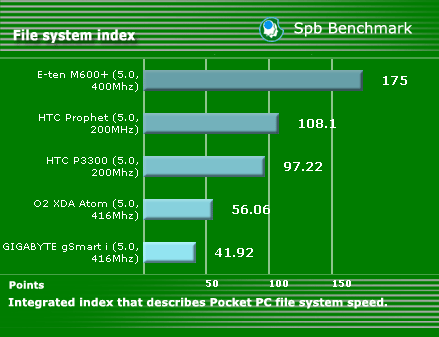
These figures display how fast device’s memory is (read/record/transfer).
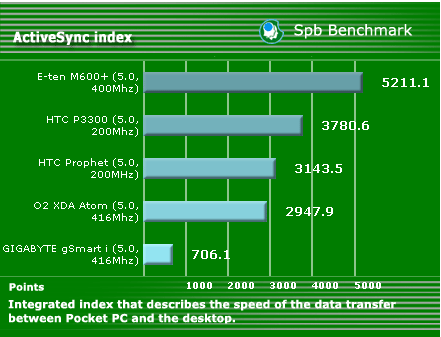
Synchronization is quite speedy (doesn’t affect the total score).
We don’t publish the total score here, as it is greatly distorted for Windows Mobile 5.0.
We tested out video with The Core Pocket Media Player (former BetaPlayer), the results are as follows. The performance depends mostly on the graphics accelerators and Wireless MMX set, embedded in the latest Intel XScale CPU. 100% performance means the smooth film rendering without dropped frames, but with possible collapses during active scenes.

Thus converting must be done before watching films on HTC P3300.
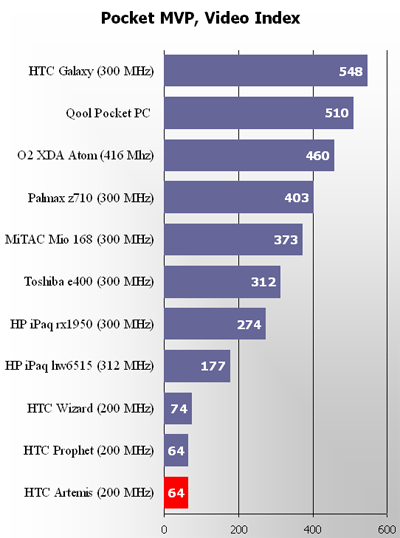
Even if we overlook the influence cast by accelerators and Wireless MMX, the video rendering speed will still have much room for improvement. Four trailers of different intensity were played back; the index was based on the number of dropped frames: The bigger index - the lower average number of dropped frames. Index 1000 means there are no missing frames at all.

Graphic performance was tested on PocketQuake game in “sound off” mode (nosound 1 in console, all other setting were on). Here is the average index of two tests (Demo 1 and Demo 2). The results are predictable, Artemis is not meant for resource-hungry games, but it is suitable for casual games (puzzles, strategies, arcades).
In general the performance put on by the P3300 matches that of HTC Wizard/Prophet. It’s not a big surprise, since both of them base on the same platform. On the whole the performance provided by the P3300 is enough for most tasks, saving for unconverted video playback, playing resource-hungry games and Skype.
Software
HTC was the first company to produce a device running on Windows Mobile 5.0 for Pocket PC OS. Basically, it was a thing that many had expected to come, especially when taking into account the close relationship between HTC and Microsoft. HTC Artemis is the first model to carry AKU 3.0 update pack onboard. Detailed reviews of Windows Mobile 5.0 as well as AKU 3.0 update pack you can find on our portal. And in this review we will describe extra preinstalled features of HTC P3300.

Review of Windows Mobile 5.0 for Smartphone >>>
Review of Windows Mobile 5.0 AKU 3.0>>>
ClearVue PDF. Application dealing with PDF documents.
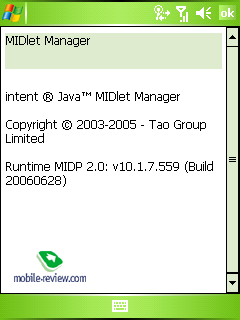
MIDlet Manager. Loads and runs java scripts.
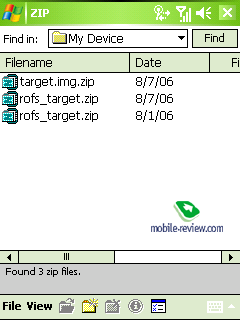
ZIP. Adds possibility to handle archives, initially disabled in WM 5.0.
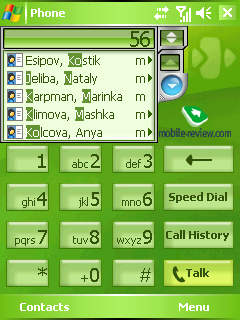
Smart Dialing. Enables fast search in contacts, similar to that found on WM for Smartphone.
As you see the range of extra features is extremely small. Of course you shouldn’t forget the TomTom feature in the standard package, but it will be described in a dedicated article.
Conclusion
The P3300 delivers good connection quality, though the same may be said about majority of up-to-date models. The volume of the ring tones is somewhere between loud and quite – one even might call it the golden mean. The silent alert produces continuous ripple.
For a long time the company’s line-up lacked model boasting GPS on board - the result of boundary conditions in contract with HP. HTC had nothing to do but launch cellular-disabled HTC Galaxy. We were feeling unsure about the upcoming model, since Galaxy’s GPS was far from the ideal. The P3300 handles GPS in a more convenient fashion that HTC Galaxy, but this aspect is to be covered in a dedicated article, which will contain information on TomTom Navigator 6 as well.
HTC Artemis is based on now quite old HTC Prophet/HTC Wizard platform, thus their performance and lifetime tests are quite similar, sometimes even alike. Should we consider HTC Prophet (Qtek S200) as the starting point, we will have the following differences between these models:
- Embedded GPS – the main innovation;
- Embedded FM-radio;
- Completely revamped design (the model has a unique face), new materials used, the device is thinner and lighter than the predecessor;
- Unique HTC RollR controls;
- Installed AKU 3.0 update pack;
- New socket for wired headset;
- Better camera quality, though without macro-mode;
- MicroSD instead of SD/MMC, maximum capacity is smaller, no hot swap feature.
On the whole all innovations, saving for memory card and HTC ExtUSB socket are mostly positive. But on the other hand they are the communicator’s major drawbacks as well. For many potential buyers the poor CPU and the small RAM capacity are likely to be the formal flaws, however most applications easily run with these resources. With new memory system in Windows Mobile 5.0, the device doesn’t need 128 Mb RAM onboard, on top of that 200+ MHz CPU is required only in case you are going for unconverted video and Skype.
HTC P3300 is hitting the shelves by the end of October – beginning of November at a starting price of 750 USD (Russian retail price), as Christmas is closing in, the price will drop down to 630-650 USD. Compare it with retail price of 660-680 USD for Mio A700 in Moscow and less than 600 USD for E-Ten G500. But before the Christmas, the P3300 will be highly pressured by E-Ten X500 and the new Mio-branded communicator, which both will get much cheaper than HTC at the same of even excelling set of features. The trumps of the P3300 that will be brought to the table by HTC are design and build quality. The very unique HTC RollR controls are grabbing each and everyone’s attention as wellThe commercial success will strongly depend on the price which will get fixed by the beginning of December. In case of adequate HTC’s pricing policy, theP3300 will get into the top of Christmas sales charts.


Anton Kotov (anton.kotov@mobile-review.com)
Translated by Oleg Kononosov (oleg.kononosov@mobile-review.com)
Published — 10 October 2006
Have something to add?! Write us... eldar@mobile-review.com
|
News:
[ 31-07 16:21 ]Sir Jony Ive: Apple Isn't In It For The Money
[ 31-07 13:34 ]Video: Nokia Designer Interviews
[ 31-07 13:10 ]RIM To Layoff 3,000 More Employees
[ 30-07 20:59 ]Video: iPhone 5 Housing Shown Off
[ 30-07 19:12 ]Android Fortunes Decline In U.S.
[ 25-07 16:18 ]Why Apple Is Suing Samsung?
[ 25-07 15:53 ]A Few Choice Quotes About Apple ... By Samsung
[ 23-07 20:25 ]Russian iOS Hacker Calls It A Day
[ 23-07 17:40 ]Video: It's Still Not Out, But Galaxy Note 10.1 Gets An Ad
[ 19-07 19:10 ]Another Loss For Nokia: $1 Billion Down In Q2
[ 19-07 17:22 ]British Judge Orders Apple To Run Ads Saying Samsung Did Not Copy Them
[ 19-07 16:57 ]iPhone 5 To Feature Nano-SIM Cards
[ 18-07 14:20 ]What The iPad Could Have Looked Like ...
[ 18-07 13:25 ]App Store Hack Is Still Going Strong Despite Apple's Best Efforts
[ 13-07 12:34 ]Infographic: The (Hypothetical) Sale Of RIM
[ 13-07 11:10 ]Video: iPhone Hacker Makes In-App Purchases Free
[ 12-07 19:50 ]iPhone 5 Images Leak Again
[ 12-07 17:51 ]Android Takes 50%+ Of U.S. And Europe
[ 11-07 16:02 ]Apple Involved In 60% Of Patent Suits
[ 11-07 13:14 ]Video: Kindle Fire Gets A Jelly Bean
Subscribe
|





















































